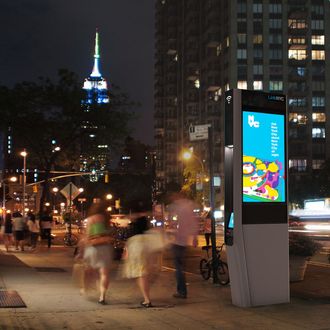
New York pay-phone kiosks, quite a few of which function solely as urinals, no longer handle a lot of actual calls. So, two years ago, the city announced a plan to replace thousands them with Wi-Fi hotspots equipped with touch screens allowing users to get directions, look up information, and even (if you plug in your headphones or use the built-in speaker setup) make phone calls. The first stations were installed late last year, and Wi-Fi on four of them was turned on in a test last month. On Thursday the program — called LinkNYC — officially launched, with more than a dozen machines along Third Avenue, mostly in the East Village, fully operational. The mayor’s office says 500 more will be installed throughout the five boroughs by the end of July. In all, at least 7,500 will be built, and perhaps as many as 10,000.
Each of the ten-foot-tall aluminum stations, which are called Links, connects to a newly laid fiber network. They provide free public Wi-Fi (which the city says is “incredibly fast” and secure) within a 150-foot radius, as well as two USB charging ports, a tablet for accessing the internet, free domestic calls using Vonage, and a 911 button for emergencies.

They’ll be rolled out gradually, as fiber-optic cable is laid to support them. Among the first areas to get the hubs this year will be Jamaica, St. George, and the South Bronx, as well as Flatbush Avenue in Brooklyn. The city says that 4,500 of the machines will be installed by mid-2019. (You’ll be able to find active Links here.) Both sides have 55-inch high-def screens displaying ads, which pay for the whole program.
Said Mayor de Blasio in a statement: “LinkNYC is the Wi-Fi network New Yorkers deserve: the largest, fastest municipal Wi-Fi network in the world – and you won’t need to insert a quarter in the slot, because it’s completely free.” Engadget tried out one of the Links and said the touch screen worked without issue, performing like a mid-priced tablet computer: “That is to say, they’re functional, but not exactly zippy.”) The Wi-Fi in Engadget’s test today wasn’t quite as fast as the last time the site’s reporters tried it, but with upload speeds of around 150 megabits per second and download speeds of 70 megabits per second, it was still, in their words, “damn impressive for free.”





























